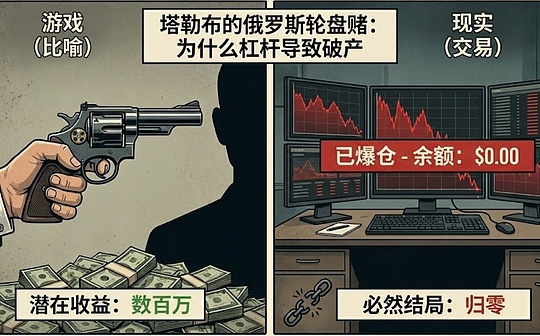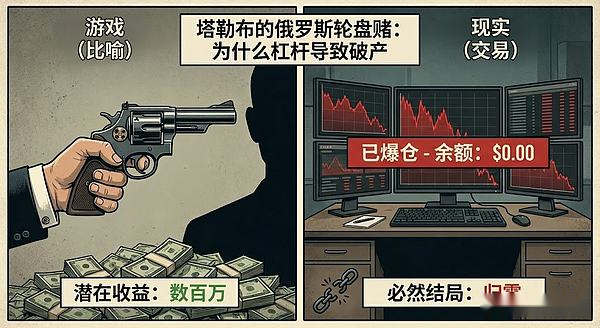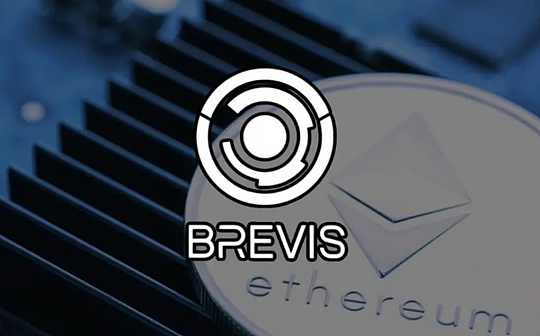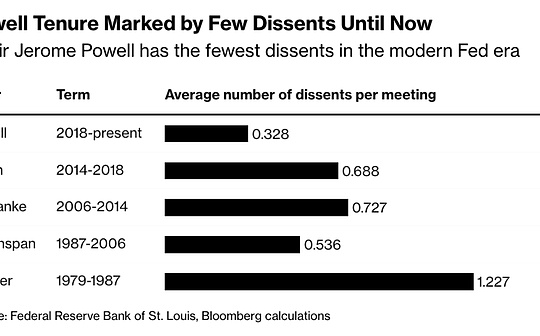
Author: BroLeon, the big lion brother of Tu’ao, source: X, @BroLeonAus
The recent cold market conditions are a good time for systematic learning. Yesterday I picked up Taleb’s “antifragile” theory and found that the phenomenon used to explain the topic is quite useful. I will record my thoughts and hope to inspire you.
If you win or lose when playing contracts but lose a lot over time, it may not be a technical problem, but that you have fallen into the trap of “non-ergodicity”.
Taleb mentioned a famous “revolver” thought experiment in “Fooled by Randomness”.This story not only explains what risk is, but also reveals why ordinary people bet on contracts for a long time, and the final outcome must be zero.
The experiment is as follows:Suppose there is a perverted billionaire who gives you a revolver with 6 magazines and 1 bullet.You pull the trigger on your head once, and if you don’t die, I’ll give you 10 million.From a probability perspective, your survival rate is 83% and your mortality rate is 17%.
Many people think: 10 million is worth the risk.

From a pure probability perspective, the probability of your survival in a one-time game is 5/6 (about 83.3%), and the probability of death is 1/6 (about 16.7%).Many people would think that using a 16.7% risk of death to win $10 million seems “worth the gamble.”But Taleb points out that this kind of thinking is wrong.
The so-called “ergodicity” simply means that “group probability” can be equated to “individual time probability”.In this game, you can’t traverse.If you find 100 people to play this game, about 83 people will get rich and 17 people will die.On average, the gains are huge.
For you personally, you only have one life.Once that 1/6 small probability event occurs, the game will be over for you forever.You can’t enjoy “average” results.The joy of those 83 successful people has nothing to do with you, you are just one of the 17 tombstones.
As long as there is even a small chance that you will be completely eliminated (death or bankrupt), in the long run, this risk is almost certain to occur.
In addition, Taleb also proposed another upgraded version of the pistol experiment, which is closer to the current situation of the currency circle:
What if you play this game once a day and are given 1 million each time?
As long as you play long enough, the probability of that bullet appearing will infinitely approach 100%.In this game, it doesn’t matter how many times you win because you can only lose once.Once you lose, the game is over and so are you.

Return to the currency circle contract.Many people use high leverage to pursue short-term huge profits.It’s like the guy turning the revolver.You may win 9 times in a row (there are no bullets in the gun), your account has doubled more than ten times, and you feel that you are a stock god and your strategy is perfect.But that’s just survivorship bias, you just haven’t moved on to that bullet yet.
Why must it return to zero?There are always “black swans” in financial markets – that bullet.
Pin insertion, exchange outage, extreme market conditions.For spot parties, this is volatility; for high-multiple contract parties, this is “destructive risk.”No matter how much you have earned before, as long as there is a risk of being “out of the game”, as the number of transactions increases, returning to zero is not a “possibility”, but a mathematical “inevitability”.
You may think that the 1011 currency disaster was a sudden and unexpected “black swan”, caused by bad luck or other objective problems.But in fact, all the elders in the currency circle know that the situation during 312 was very similar to that of 1011 in many aspects. It was only 5 years ago that it happened. Newcomers who entered the circle after 2020 have not experienced it.
Most of the friends around me who have signed contracts with 1011 and have not had any problems this time are old leeks who have gone through the baptism of 312 and have been psychologically prepared for the worst-case scenario of 312.
The value gained from Taleb’s wisdom is:Don’t take unlimited (destructive) risks for limited gains.As long as there is the possibility of “blowing out”, your mathematical expectation in the long run is zero.Want to survive in the market?The first principle is not to make money, but to ensure that you never get hit by that bullet.
This is consistent with the philosophy that I have always emphasized to be patient, not to over-expose myself to risks, and not to play poker.
So should retail investors use leverage tools?
Of course, I am not mindlessly opposed to using leverage.In my opinion, if there really is an opportunity to “win 10 million US dollars with a 16.7% death risk”, in reality, many people will be willing to try it. After all, it is too difficult to earn the principal.
The biggest charm of the currency circle is that there are a lot of opportunities to make big gains with small things, and high leverage is one of them.But most retail investors have two problems:
-
You won’t just fire one shot, you will feel like you are the chosen one if you take 10 million without dying, and then you will continue to fire one shot after another until you encounter a bullet.
-
There is no strict trading discipline, especially stop loss.Using full margin without setting a stop loss and not preparing for the worst-case scenario is basically a prelude to zero.
final summary
For any game with “destructive risk”, the first thing you need to consider is whether you can accept the loss in the worst case scenario (bullets are fired), rather than considering how high the potential gains are.
The risk must be within your acceptable range, and treat every contract transaction seriously as if you are pulling the trigger on Russian roulette.
I personally think Taleb’s theory is quite helpful to me. If you are interested, you can read it when you have time.






